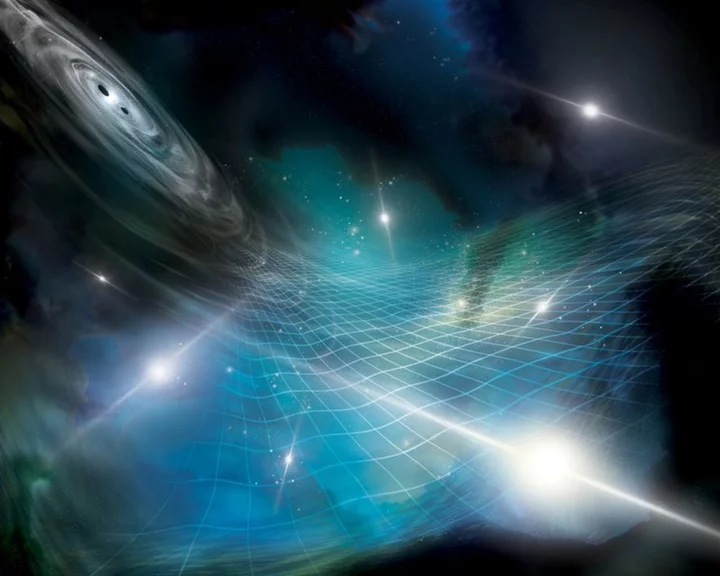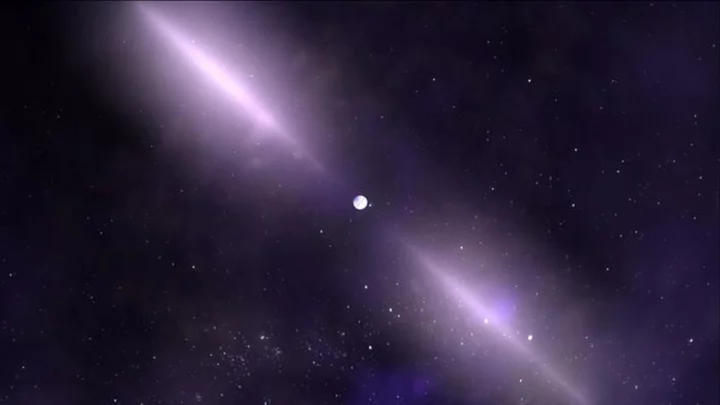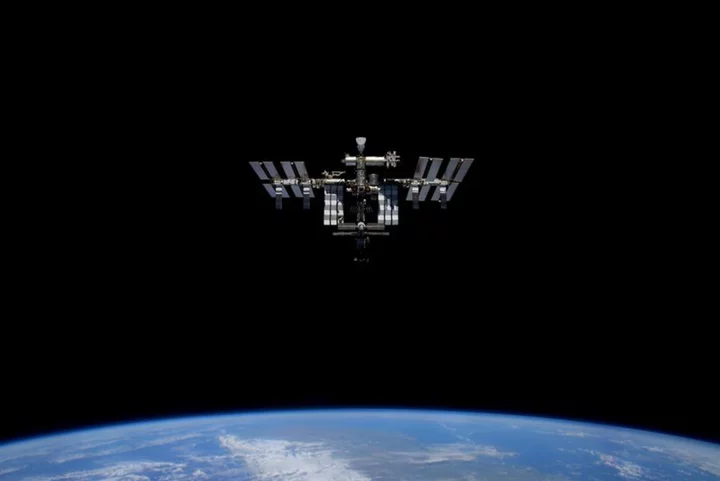
Scientists discover that universe is awash in gravitational waves
By Will Dunham WASHINGTON Scientists on Wednesday unveiled evidence that gravitational waves, the ripples in the fabric of
2023-06-29 10:58

Scientists find entirely new kind of gravitational wave in unprecedented breakthrough
Scientists have “heard” a chorus of gravitational waves rippling through the universe, in what they say is an unprecedented finding that could fundamentally change our understanding of the universe. The discovery, described in a range of newly published journal papers, suggests that spacetime is being rocked by intensely powerful gravitational waves all the time. Those waves carry a million times more energy than the one-off bursts of gravitational waves that were detected from a black hole and were themselves hailed as a major breakthrough in our understanding of the universe. The new results suggest that everything is being slowly shrunk and expanded by a new kind of gravitational wave as they pass through our galaxy. Scientists describe it as being akin to hearing a “symphony” of waves echoing through the universe. “It’s like a choir, with all these supermassive black hole pairs chiming in at different frequencies,” said Chiara Mingarelli, a scientist who worked on the new findings while an associate research scientist at the Flatiron Institute’s Center for Computational Astrophysics. “This is the first-ever evidence for the gravitational wave background. We’ve opened a new window of observation on the universe.” The new findings have been described in a range of journal articles, published in different academic journals. The research is the result of 25 years of observations from six of the world’s most sensitive radio telescopes, and have been simultaneously published by different collaborations across the world. The findings are not only notable in themselves. They also offer the opportunity to find out some of the universe’s secrets, since they can be used to find information about the binary black holes that form when galaxies merge, for instance. “These results signify the beginning of an exciting journey into the Universe, where we aim to unravel its mysteries,” Michael Keith, a lecturer at Jodrell Bank Centre for Astrophysics, UK, and contributor to one of the new studies, published in Astronomy and Astrophysics. “After decades of tireless work by hundreds of astronomers and physicists worldwide, we are finally detecting the long-awaited signature of gravitational waves originating from the distant Universe.” Scientists made the discovery by analysing observations of pulsars, which are extinguished stars that can be used as reliable clocks in the distant universe. By bringing together such a large amount of detailed data, researchers were able to measure those pulsars with very high accuracy, allowing them to measure gravitational waves at a far larger scale than using detectors on Earth. “Pulsars are excellent natural clocks. We exploit the remarkable regularity of their signals to detect subtle changes in their rhythm, enabling us to perceive the minute stretching and squeezing of space-time caused by gravitational waves originating from the far reaches of the Universe,” said David Champion, a senior scientist at the MPIfR in Bonn, Germany, and contributor to the study, in a statement. For now, researchers are only able to “hear” the vast choir, rather than the individual pulsars that make up its singers. But together they are much louder than expected, meaning that there may be more or more heavy supermassive black holes to be found in the universe. Read More Astronomers find zombie planet that ‘shouldn’t exist’ Nasa to begin Moon mining within next decade Nasa rover spots bizarre donut shaped rock on Mars
2023-06-29 08:18

Astronomers find zombie planet that ‘shouldn’t exist’
Scientists have found a new planet they shouldn’t exist, after it seemed to miraculously survived the violent death of its star. Many planets, including our own, face almost certain doom when their stars reach the end of their lives and engulf them. When our own Sun dies, for instance, it will expand to 100 times and swallow the Earth. But the new study offers hope that at least some of those planets are able to survive. The newly discovered world, a Jupiter-like planet known as Halla, managed to survive the demise of its star Baekdu, in what should have been certain death. Astronomers found the planet and discovered through follow-up observations that Baekdu had previously expanded into a red giant. When it did, it would have inflated up to 1.5 times the distance between it and Halla, engulfing the star, and then shrunk back down to its current size. Despite that dramatic and violent event, Halla has managed to persist, sticking around so that astronomers could see it using telescopes in Hawaii. “Planetary engulfment has catastrophic consequences for either the planet or the star itself - or both. The fact that Halla has managed to persist in the immediate vicinity of a giant star that would have otherwise engulfed it highlights the planet as an extraordinary survivor,” said Marc Hon, the lead author of the study. The findings are published in a new paper, ‘A close-in giant planet escapes engulfment by its star’, in the journal Nature today. Halla was found in 2015, using what scientists call the “radial velocity method”, which monitors how stars move and uses that to understand how they might be tugged around by the planets that orbit them. In the years since, scientists found that the planet must have been engulfed by the star, and conducted follow-up observations to better understand the planet. Those observations confirm that the planet had been in its stable orbit for over a decade, and that it really existed. “Together, these observations confirmed the existence of the planet, leaving us with the compelling question of how the planet actually survived,” said IfA astronomer Daniel Huber, second author of the study. But scientists still do not know how it survived. One possibility is that it started on a larger orbit before moving closer to its star, but astronomers believe that is unlikely. Another is that Baekdu was actually once two stars. They may have merged during their death, sparing Halla from being merged at all, by stopping them getting big enough to engulf it. And a separate possibility is that Halla was actually born out of the collision of the two stars. That might have produced a gas cloud that actually gave birth to Halla, and so it may be the result of the demise of its star rather than a survivor of it. Read More Nasa rover spots bizarre donut shaped rock on Mars Strange alien planet could be trapped in edge of the Solar System SpaceX Starship completes six-engine static test fire at base in Texas
2023-06-28 23:26

Study reveals how immune system of astronauts breaks down
By Will Dunham WASHINGTON Evidence is growing about the many ways that traveling in the microgravity environment of
2023-06-22 12:49

Our nearest supermassive black hole ‘became active’ and became a million times intense, scientists say
Our nearest supermassive black hole awoke from a “period of dormancy”, becoming a million times more intense, scientists have said. The supermassive black hole, known as Sagittarius A*, sits at the heart of the Milky Way and is about four million times more massive than the Sun. About 200 years ago, it ate cosmic objects that got too close to it and became vastly more bright, scientists found. The increase in brightness is as if a single glow-worm hidden in a forest suddenly became as bright as the Sun, according to researchers. The intense event was discovered by scientists who picked up an X-ray “echo” from the event. It also explains the intense bright shine of galactic molecular clouds around the black hole – scientists say they are reflecting those X-rays that came out of the black hole towards the start of the 19th century. The work is described in a new paper, ‘X-ray polarization evidence for a 200 years-old flare of Sgr A*’, published in Nature. Read More Jupiter is struck by neon green lightning bolt in stunning Nasa photo Humans have affected the Earth’s rotation, scientists say First disabled astronaut says his selection sends ‘powerful message’
2023-06-21 23:18

Spain's PLD Space aborts test rocket launch -webcast
Spanish startup PLD Space aborted a test launch of its reusable Miura-1 rocket at the last moment early
2023-06-17 09:47

Major finding on Saturn moon boosts hope for finding alien life nearby
Phosphates have been found on Saturn’s moon Enceladus, in a new breakthrough discovery that boosts hopes for finding alien life in our solar system. It is the first time phosphorus has been found in an ocean beyond those on Earth, and marks a major development in our understanding of other ocean worlds. Enceladus is one of the most likely hopes for finding nearby extraterrestrial life. While its outside is wrapped in an ice crust, underneath is a global ocean that could be a home for alien life. Some of that ocean spews up and out of the surface of Enceladus, in the form of vast plumes. Scientists have been able to examine those plumes to better understand the ocean itself, including in the new study. Researchers in the latest study used data from the Cassini mission – which flew around Saturn and Enceladus – to find out what the oceans are made up of. They not only found phosphorus, but data suggested that it could be there are concentrations at least 100 times higher than in Earth’s oceans. What’s more, modelling based on the new data suggests the same could be true for other ocean worlds, potentially boosting the chances of alien life there, too. Phosphorus is not in itself evidence of life. But on Earth, the presence of phosphorus compounds in water are crucial for biological activity, and so it is a key part of evaluating whether a distant world might support life. The work is described in a new paper, ‘Detection of phosphates originating from Enceladus’s ocean’, published in Nature. The breakthrough is just the latest in a series of findings from Enceladus. Recently, scientists found that the moon’s plumes were particularly vast, shooting out 20 times the length of the planet itself and with enough water to fill an olympic swimming pool in a couple of hours. Unlike the new phosphorus findings, which relied on the Cassini spacecraft sent by Nasa to Saturn, that work was conducted by the James Webb Space Telescope, which scientists hope will allow us to understand the distant moon in much more detail. Read More Watch: Strawberry moon lights up skies over UK Nasa invites public to sign ‘message in a bottle’ that will fly to Jupiter’s moon Watch as astronauts step out of ISS for latest spacewalk
2023-06-16 04:58

Virgin Galactic plans first commercial spaceflight in June, shares jump
Virgin Galactic Holdings, the space tourism firm founded by Richard Branson, said on Thursday its first commercial spaceflight
2023-06-16 04:57

Geminids meteor shower began life in a ‘violent catastrophe’, scientists say
The Geminids meteor shower began in a “violent catastrophe”, scientists have found. Every winter, the world is delighted by the meteor shower, which brings some of the most intense display of ‘shooting stars’. But that spectacle has been rivalled by its mystery. The Geminids are unusual in that most meteor showers are created when a comet leaves behind a tail of ice and dust – but the Geminids come from an asteroid, which do not usually leave behind a tail. Asteroids are chunks of rock and metal flying around in space. The Geminids appear to originate with one called 3200 Phaethon, which for an unexplained reason is affected by the Sun and leaves behind a stream across the night sky. “What’s really weird is that we know that 3200 Phaethon is an asteroid, but as it flies by the Sun, it seems to have some kind of temperature-driven activity,” said Jamey Szalay, research scholar at the Princeton University space physics laboratory and co-author on the paper. “Most asteroids don’t do that.” Attempts to solve that mystery have struggled in part because the meteor shower has only been observed from Earth. Now, however, researchers using Nasa’s Parker Solar Probe have been better able to examine the the Geminids. They suggest that a violent, catastrophic event gave rise to the meteor shower. That could have been a high-speed collision with another object in space, for instance, or a gaseous explosion. Some researchers have previously suggested that 3200 Phaethon might really be a comet, and that it lost its snow to leave behind just a rocky core that looks like an asteroid. But the new study makes clear that the origins of the meteor shower are much more dramatic than that. In an attempt to understand the meteor shower, researchers simulated three possible formation scenarios and then compared them with models based on observations from the Parker Solar Probe. That included a less violent scenario, a more violent one, and another that was in line with a comet. When they compared those scenarios with the actual observations, they found that the violent one was the most similar. That suggests that it was the result a collision or similar dramatic event. Researchers still do not know for sure what happened. But the new study helps narrow down the possibilities – as well as shedding more light on such events in space. The findings are published in a new article, ‘Formation, Structure, and Detectability of the Geminids Meteoroid Stream’, published in Planetary Science. Read More Watch live as astronauts step out of ISS for latest spacewalk Major finding boosts hope for finding alien life in our solar system Astronomers find rare planet circling two stars like Star Wars’s Tatooine
2023-06-15 23:54

Major finding on Saturn’s moon Enceladus boosts hope for finding alien life in our solar system
Phosphates have been found on Saturn’s moon Enceladus, in a new breakthrough discovery that boosts hopes for finding alien life in our solar system. It is the first time phosphorus has been found in an ocean beyond those on Earth, and marks a major development in our understanding of other ocean worlds. Enceladus is one of the most likely hopes for finding nearby extraterrestrial life. While its outside is wrapped in an ice crust, underneath is a global ocean that could be a home for alien life. Some of that ocean spews up and out of the surface of Enceladus, in the form of vast plumes. Scientists have been able to examine those plumes to better understand the ocean itself, including in the new study. Researchers in the latest study used data from the Cassini mission – which flew around Saturn and Enceladus – to find out what the oceans are made up of. They not only found phosphorus, but data suggested that it could be there are concentrations at least 100 times higher than in Earth’s oceans. What’s more, modelling based on the new data suggests the same could be true for other ocean worlds, potentially boosting the chances of alien life there, too. Phosphorus is not in itself evidence of life. But on Earth, the presence of phosphorus compounds in water are crucial for biological activity, and so it is a key part of evaluating whether a distant world might support life. Read More Astronomers find rare planet circling two stars like Star Wars’s Tatooine Elon Musk to launch biggest ever rocket after dramatic failure US government contradicts whistleblower’s claims of possible ‘non-human’ material
2023-06-14 23:21

Spanish rocket company PLD Space signs deal with France's Arianespace
MADRID Spanish startup PLD Space has signed an agreement with France's Arianespace to develop joint services to launch
2023-06-14 22:49

Elon Musk to launch biggest ever rocket after dramatic failure
SpaceX will attempt to launch its Mars-bound Starship rocket within the next eight weeks, Elon Musk has announced. It will be the second time SpaceX has attempted an orbital launch of its Starship system, which is the biggest and most powerful rocket ever developed. The first attempt at an orbital Starship launch took place in April, ending in a dramatic explosion just minutes after lift-off. Responding to a request on Twitter for an update on Starship, Mr Musk said the next test would be in “6 to 8 weeks”. The SpaceX boss has previously said that he hopes to build an entire fleet of Starship rockets in order to transport people and cargo across the Solar System. The private space company has already signed a mult-billion dollar deal with Nasa to use Starship for its Artemis programme, which aims to return humans to the Moon within the next few years. The launch site for the next orbital flight test will be from SpaceX’s Starship facility in Texas. If successful, the rocket will then complete a 90 minute journey around the Earth before touching down off the coast of Hawaii. No crew will be aboard the stainless steel Starship, which stands 120 metres tall and is capable of 16.7 million pounds of thrust – twice the power of the Saturn V rocket that took humans to the Moon. The size of the rocket, which has two main stages, means it is powerful enough to lift up to 250 tons into orbit, or carry 100 people on a trip to Mars. Read More Elon Musk eyes ‘highly habitable’ planet that’s ‘practically next door’
2023-06-13 23:24
